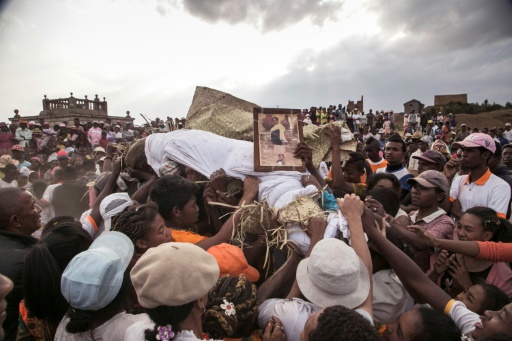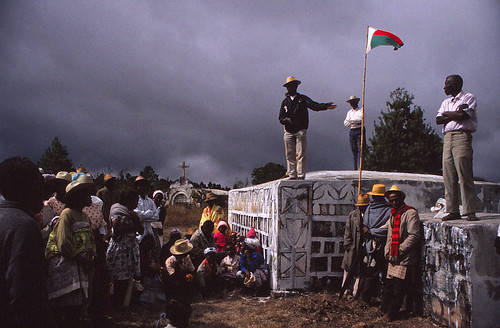Famadihana Funeral Rites from Madagascar
Long Live the Dead!
 For the Malagasy people, the grave is just another dwelling place where the whole family will eventually reunite. “Alive, the same house, dead, the same grave,” says the proverb.
For the Malagasy people, the grave is just another dwelling place where the whole family will eventually reunite. “Alive, the same house, dead, the same grave,” says the proverb.
From July to November, the “famadihana” enlivens the highlands, a joyful reunion of the living and the ancestors.
The custom of turning the dead has resisted past missionary zeal and health purism.
The Malagasy observe two funeral rites
The first one brings the individual. From the world of the living to the world of the dead; the second brings the deceased into the world of ancestors and installs their protective power. There are regional variations of this ceremony, but the most well-known are those practiced by the Merina under the name famadihana and the Sihanaka under the name jamà.
These ceremonies involve bringing a distant deceased person back to the family tomb or exhuming the mortal remains of a deceased person as well as those of the great ancestor and sometimes other ancestors to offer them new shrouds. Explore more about this fascinating tradition in Madagascar here: [link to image].
Customs during Famadihana
Second burial, hence “Famadihana”, the ceremony takes place during the southern winter between June and September.
It is common for an ancestor to appear to one of their descendants in a dream to complain about the cold: the family then consults an astrological diviner (mpanandro) who determines the right date for the ritual.
Duty of the Descendants
The zana-drazana, descendants of the people exhumed during famadihana, are the central actors of the ceremony. They are the instigators, hoping to reap the rewards. The color of their attire prescribed by the astrological diviner.
Distinguishing them from other participants.
Day of the Dead, Day of the Living
No Famadihana without music.
The celebrations take place amidst the noise of brass instruments, flutes, clarinets, and drums of a brass band.
No festival of the dead without decibels, which are an integral part of the rituals.
The expression “a noise to wake the dead” is similar to reality in Madagascar. Because the dead hear and dance with the living.
An ensemble of clarinets and trumpets accompanies the tireless dancers, some of whom 
All generations of the same family are gathered to sing and have fun.
The atmosphere is reminiscent of a wedding or a big birthday party, but the celebrations are taking place around a grave.
In fact, they are called the day before the festivities of the ceremony so they can return to their final resting place.
They must pay homage to their ancestors, but also delight the living. To celebrate their connection with their ancestors, the Zana-drazana (the children of the ancestors) walk around the grave seven times, dance, carry the remains wrapped in their new shroud on their head or shoulders.
If some.
If tears are shed during Famadihana, they are done discreetly, as this ritual must be a moment of joy.
Regional Differences
Exhumation: ati-damba
Among the Sakalava people of Menabe, this ritual, known as ranga an-dolo, takes place one year after the burial.
The Betsimisaraka from the northeast perform this rite two or three years after death and call it famongarana.
On the other hand, the Betsimisaraka from the central-east region let their deceased rest in peace, but they erect “male” (vatolahy) or “female” (vatovavy) stones, which they periodically wrap in a shroud of ordinary cloth.

Even the Betsileo, who call the ceremony ati-damba, do not bring the dead out of their graves.
This ritual has different regional forms, several of which have deep symbolic similarities: the famongarana predominates among the northern Betsimisaraka, the ranga an-dolo is a Sakalava ceremony of Menabe, while the jamé is perpetuated by the Sihanaka.
Despite the differences in forms, which are linked to local history and identity structures, there is a common significance in the rituals of all regions: each one is a fundamental ritual.
Ceremony honoring the deified ancestors.
Ancestors who have been sanctified in this way are asked to bless their descendants and exercise protective power over them.
Funeral ceremony
The brass band, perched above the grave, plays the songs in a steady rhythm as the bodies follow one another.

The bodies of the deceased are wrapped in shrouds covered with willow mats.
The descendants then carry them on their shoulders, dance, and drink alcohol.
Sometimes they pour a generous shot of alcohol over the bodies of their ancestors.
The scene may seem morbid from the outside. But there are no tears or sad faces here.
There is an atmosphere of excitement. “What is the atmosphere like?” I am often asked if I am also having fun.
A costly ritual
Originally, exhumation was practiced when a person died far away from their place of origin. A feast took place when the deceased’s body was returned to their family.
The economic situation often does not allow the majority of the Malagasy population to buy shrouds during the “famadihana” period.
A “famadihana” is organized at intervals of 3, 5, or 7 years, but due to lack of means, some cannot follow this tradition.
The ceremony is sometimes associated with colossal costs, with festivities lasting 2 days and many guests needing to be fed.
The “vary be menaka”, rice soaked in oil accompanied by zebu meat, is a traditional dish served during the celebration. One of the menus that delights the whole family.
In addition to the cost of the food, there are also costs for the music band and the “lambamena”, a silk cloth that covers the body of the deceased to protect them from the cold.
However, due to declining purchasing power, many Malagasy households no longer have the luxury of buying traditional “lambamena” and opt for synthetic fabrics instead.
Malagasy families save for a long time and sometimes go into debt to honor their deceased with a “famadihana”.
 When it comes to seeking the help of the deceased, the Malagasy people use the “Famadihana” ceremony.
When it comes to seeking the help of the deceased, the Malagasy people use the “Famadihana” ceremony.
Endogenous Aspects of a Ceremony
The stories collected in the villages give the Famadihana a different dimension, both in terms of its sacred meaning and as a vector of social cohesion.

Death is an integral part of the life process.
The ancestors are present in the symbolic imagination of the living. This happens on a playful level: it is not uncommon to meet children who playfully represent the Famadihana in symbolic transpositions and carry grasshoppers wrapped in banana leaves as if they were the body of an ancestor.
Orality and closeness to ancestors
In addition, riddles from oral tradition refer to the essential sacred act of sacrificing the new burial shroud: the lambamena, the burial shroud, is sacred, but it is also the subject of spirit games.
This riddle shows the complexity of the relationship maintained with the ancestors, one can even make jokes about them:
We open the coffin, take the Remove the shroud and eat the corpse, what is it?
… … ?
It’s a peanut.
Spirituality and Astrology
When it comes to the periodicity and determination of the organization of a Famadihana, we have heard a recurring story that the deceased appears in a dream to one of their descendants, telling them that they are cold.

And also to gather many people around him and to let him dance on the occasion of a great festival.
The Famadihana is the community of the living who ask for the blessing of the dead, and a tribute to Tanindrazana, the land of ancestors, the Malagasy homeland.
The relationship between the listeners gathered around the grave and the astrologer presiding over the ceremonies is always mixed with politeness and constant references to the values shared by the group.
The Kabary (speech of the astrologer, the council of elders, and the official authorities) is an essential part of the ceremony.
The inside approach allows us to. To promote a real visual anthropology of rituals by highlighting the expression of group participation and the various levels and layers of this ancestor worship: dreams and astrology, economy, psychological relationships, hierarchical lines of performance.



 When it comes to seeking the help of the deceased, the Malagasy people use the “Famadihana” ceremony.
When it comes to seeking the help of the deceased, the Malagasy people use the “Famadihana” ceremony.




